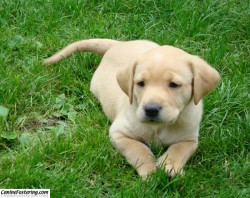10 Tips For Your New Puppy
Willow‘s puppies all went home today with their new forever families. Here are tips for all families that bring home a new puppy:
 Limit the number of rooms the puppy/dog has access to for the first week or so.
Limit the number of rooms the puppy/dog has access to for the first week or so.- Limit the amount of “attention” you give the new member of your family for the first few days…let them get acclimated a bit.
- Place the crate in a bedroom for the first few nights or sleep next to the crate. Remember, all the puppies slept lumped together, spending the night alone will really be scary and having you nearby will greatly help.
- Unless you want a dog that whines in her crate, do not let her out when she is crying/whining/pawing or barking. Wait until she quiets and then let her out. To avoid this, set an alarm for every 3 or 4 hours that first night and wake her up to take her potty. Soon you will be able to cut out those middle of the night potty breaks but if you do this for that first few nights (first week?) it will really pay off. The alternative, letting the dog wake you up can lead to reinforcing whining and barking in the crate. We don’t want that!
 Take your new family member to the same spot in the yard every time he transitions to a new activity (or every hour or two) and tell him “go potty” or some such command. If nothing happens in a few minutes, come back inside.
Take your new family member to the same spot in the yard every time he transitions to a new activity (or every hour or two) and tell him “go potty” or some such command. If nothing happens in a few minutes, come back inside.- Watch for nervous behavior, circling and sniffing the ground, whining – these are cues that your puppy needs to poop.
- You have 3 seconds to reward or correct a behavior! That’s it! So, unless you catch the puppy in the act of peeing, scolding him will only make him afraid of you. If you miss it, let it go and commit to being more attentive in the future.
- Your puppy won’t need a real walk until they are about 4 months of age but do get them used to their leash and collar by putting them on and walking around the yard and house.
- Remember: these guys (Willow included) are like blank slates…they will learn what you teach them or let them do regularly. Be mindful not to condition them to expect behavior that you won’t want a full grown dog to do. A good example, letting them pull you to the door. As anxious as you are to get the out to potty, try to keep good leash manners in front of your mind. Walk to the door with the dog/pup at you side or behind you. Go out the door first, then the pup/dog. Once outside, give a command word as you walk to your potty spot and then let them have full reign of the leash. Otherwise, you are teaching a dog to pull on leash while you are house training it!
 Remember to love them up good but don’t “cut them slack” – keep in mind the behavior you want and reinforce it (with cuddles, praise and treats) and ignore or correct (NOT PUNISH – just make a disapproving sound – I like AH!) behavior you don’t want. They will appreciate the clarity.
Remember to love them up good but don’t “cut them slack” – keep in mind the behavior you want and reinforce it (with cuddles, praise and treats) and ignore or correct (NOT PUNISH – just make a disapproving sound – I like AH!) behavior you don’t want. They will appreciate the clarity.
Cherish your new family member!
Puppy Report
A lot has happened, I hope I can remember it all. First of all, I called everyone who adopted puppies and heard back from everyone …and everyone had WONDERFUL things to say about their new family members! I was thrilled. Everyone seemed to be doing well and really falling in love with their new dog. Some families reported that potty training was nearly complete, others that it was still in full swing. Both of these extremes (and everything in between) are normal for puppies. They are small, and subsequently their bladders are small and therefore they need to pee frequently. Add to that the lessons they have to learn about holding it and indicating to us when they need to go and it makes sense that this first lesson is a difficult one for some pups.
The families with resident dogs reported that their puppies had inserted themselves into their pre-existing dog packs with confidence, some even trying out their dominance at this young age! (more…)
House Training Your Puppy
For anyone adopting a new puppy, here are my two principles of house training:
1) Keep your puppy nearby (attached by leash is best) for the first few days you get him and EVERY SINGLE TIME he starts sniffing around take him outside to the same spot and give the same command (“go pee”, “go potty outside”, “hurry up” or whatever you want).
2) For the first month or so, after every transition, take your puppy outside (see #1 above). That means after waking, playing, eating, drinking, chewing, coming out of the crate, or snuggling. Do this every single time. I know it sounds terrible and it is true, you do end up taking the puppy out (more…)




